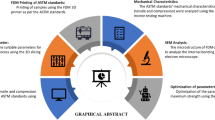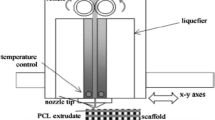Abstract
Three-dimensional (3D) printing is a form of additive manufacturing that employs digital model data to build real objects by layering on materials. The technology has found use in the automotive, aerospace, and biomedical industries. Fused deposition modeling (FDM) is a popular 3D printing technique used for production of thermoplastic polymer materials. In this work, polyether ether ketone (PEEK) material being used a biomaterial for a biomedical implant is investigated to evaluate improvement of mechanical strength and surface quality of the print. Infill density (ID), infill pattern (IP), and printing speed (PS) are considered as process parameters to study their influence on responses, viz., surface roughness (SR), ultimate tensile strength (UTS), and Rockwell hardness (RH). The developed predictive models for three responses are found accurate with higher values of R2 and R2 (adj) and maximum average error found as 1.38% for hardness. The infill pattern, followed by layer height, has the greatest impact on the performance measures. Increased infill density and low printing speed produce strong part having maximum ultimate tensile strength. According to a SEM image, the best material pack to generate strong specimens with the highest mechanical strength is one that has the highest infill density and the slowest printing speed (UTS = 59.09 MPa; RH = 64.31). Parametric optimization to optimize single and multi-responses was carried out using desirability analysis (DA) and the results show that 72.93% infill density, printing speed of 25 mm/sec, and gyroid pattern having composite desirability value of 0.8884 are found optimum.













Similar content being viewed by others
References
I.V. Panayotov, V. Orti, F. Cuisinier, and J. Yachouh, Polyether Ether Ketone (PEEK) for Medical Applications, J. Mater. Sci. Mater. Med., 2016, 27, p 118.
R. Ghomi, E. Eshkalak, S.K. Singh, S. Chinnappan, A. Ramakrishna, and R. Narayan, Fused Filament Printing of Specialized Biomedical Devices: A State-of-the Art Review of Technological Feasibilities with PEEK, Rapid Prototyp. J.urnal, 2020, 27(3), p 592–616.
S.M. Kurtz, Synthesis and Processing of PEEK for Surgical Implants. PEEK Biomaterials Handbook, 9–22 2012.
X. Yang, Q. Wang, Y. Zhang, H. He, S. Xiong, P. Chen, C. Li, L. Wang, G. Lu, and Y. Xu, A Dual-Functional PEEK Implant Coating for Anti-Bacterial and Accelerated Osseointegration, Colloids Surfaces B: Biointerfaces, 2023, 224, p 113196.
S. He, C. Duan, S. Wang, Y. Yu, Y.K. Chan, X. Shi, J. Huang, S. Wang, S. Peng, and Y. Deng, Fusion Peptide-Engineered Polyetheretherketone Implants with Photo-Assisted Anti-Pathogen and Enhanced Angiogenesis for In Vivo Osseointegrative Fixation, Chem. Eng. J., 2022, 446, p 137453.
B.N. Turner, R. Strong, and S.A. Gold, A Review of Melt Extrusion Additive Manufacturing Processes: Process Design and Modelling, Rapid Prototyping Journal, 2014, 20(3), p 192–204.
Rehekampff, C., Schroeffer, A., Irlinger, F., Lueth, and T. C., Influence of Infill Structures and Process Parameters on the Tensile Strength of 3D-printed PEEK Parts. IEEE International Conference on Robotics and Biomimetics (ROBIO),1633-1338, Dali, China 2019.
M. Moradi, M. Karamimoghadam, S. Meiabadi, S. Rasool, G. Casalino, M. Shamsborhan, P.K. Sebastian, A. Poulose, A. Shaiju, and M. Rezayat, Optimizing Layer Thickness and Width for Fused Filament Fabrication of Polyvinyl Alcohol in Three-Dimensional Printing and Support Structures, Machines, 2023, 11, p 844. https://doi.org/10.3390/machines11080844
M. Moradi, A. Aminzadeh, and D. Rahmatabadi et al., Statistical and Experimental Analysis of Process Parameters of 3D Nylon Printed Parts by Fused Deposition Modeling: Response Surface Modeling and Optimization, J. Mater. Eng. Perform., 2021, 30, p 5441–5454. https://doi.org/10.1007/s11665-021-05848-4
M. Moradi, R. Beygi, and N. Mohd. Yusof et al., 3D Printing of Acrylonitrile Butadiene Styrene by Fused Deposition Modeling: Artificial Neural Network and Response Surface Method Analyses, J. Mater. Eng. Perform., 2023, 32(4), p 2016–2028. https://doi.org/10.1007/s11665-022-07250-0
H. Wang, M. Xu, and W. Zhang et al., Mechanical and Biological Characteristics of Diamond-like Carbon Coated Poly Aryl-Ether-Ether-Ketone, Biomaterials, 2010, 31, p 8181–8187.
M. Rosentritt, V. Preis, M. Behr, N. Sereno, and C. Kolbeck, Shear Bond Strength Between Veneering Composite and PEEK After Different Surface Modifications, Clin. Oral Invest., 2015, 19, p 739–744.
S. Najeeb, M.S. Zafar, Z. Khurshid, and F. Siddiqui, Applications of Polyether Ether Ketone (PEEK) in Oral Implantology and Prosthodontics, J. Prosthodont. Res., 2016, 60, p 12–19.
B.I. Oladapo, S.A. Zahedi, S.O. Ismail, and F.T. Omigbodun, 3D Printing of PEEK and its Composite to Increase Biointerfaces as a Biomedical Material—A Review, Colloids Surfaces B: Biointerfaces, 2021, 203, p 111726.
Q. Miao, Z. Dai, G. Ma, F. Niu and D. Wu, CF/PEEK Interleaved Laminates with PEEK Film Interleaving Manufactured by Laser-Assisted Forming: Microstructure and Interlaminar Shear Strength, Compos. Part A: Appl. Sci. Manuf., 2023, 172, p 107592.
S. Xiaoyong, C. Liangcheng, M. Honglin, G. Peng, B. Zhanwei, and L. Cheng, Experimental analysis of high temperature PEEK materials on 3D printing test. Proceedings: 9th International Conference on Measuring Technology and Mechatronics Automation, ICMTMA 2017,13-16.
J.K. Abifarin, C. Prakash, and S. Singh, Optimization and Significance of Fabrication Parameters on the Mechanical Properties of 3D Printed Chitosan/PLA Scaffold, Mater. Today: Proc., 2021, 50(5), p 2018–2025.
K. Yang, F. Zhang, Y. Chen, H. Zhang, B. Xiong, and H. Chen, Recent Progress on Carbon-Based Composites in Multidimensional Applications, Compos. Part A: Appl. Sci. Manuf., 2022, 157, p 106906.
Y. Li and Y. Lou, Tensile and Bending Strength Improvements in PEEK Parts Using Fused Deposition Modelling 3D Printing Considering Multi-Factor Coupling, Polymers, 2020, 12(11), p 2497.
P. Wang, B. Zou, H. Xiao, S. Ding, and C. Huang, Effects of printing parameters of fused deposition modeling on mechanical properties, surface quality and microstructure of PEEK, J. Mater. Process. Tech., 2019, 271, p 62–74.
W. Wenzheng, P. Geng, G. Li, D. Zhao, H. Zhangand, and J. Zhao, Influence of Layer Thickness and Raster Angle on the Mechanical Properties of 3D-Printed PEEK and a Comparative Mechanical Study between PEEK and ABS, Materials, 2015, 8, p 5834–5846.
M. Mokhtari, E. Archer, N. Bloomfield, E.H. Jonesa, and A. McIlhagger, High-Performance and Cost-Effective Melt Blended Polyether Ether Ketone/Expanded Graphite Composites for Mass Production of Antistatic Materials, Polym. Int., 2021, 70(8), p 1137–1145.
Y. Wang, W.D. Müller, A. Rumjahn, F. Schmidt, and A.D. Schwitalla, Mechanical Properties of Fused Filament Fabricated PEEK for Biomedical Applications Depending on Additive Manufacturing Parameters, J. Mech. Behav. Biomed. Mater., 2021, 115, p 104250.
R. Kumar, G. Singh, and A. Chinappan et al., On Mechanical, Physical, and Bioactivity Characteristics of Material Extrusion Printed Polyether Ether Ketone, J. Mater. Eng. Perform., 2023, 32, p 5885–5894. https://doi.org/10.1007/s11665-022-07519-4
H. Spece, T. Yu, A.W. Law, M. Marcolongo, and S.M. Kurtz, 3D printed porous PEEK created via fused filament fabrication for osteoconductive orthopaedic surfaces, J. Mech. Behav. Biomed. Mate., 2020, 109, p 103850.
D. Le, C.H. Nguyen, and T.H.N. Pham et al., Optimizing 3D Printing Process Parameters for the Tensile Strength of Thermoplastic Polyurethane Plastic, J. Mater. Eng. Perform., 2023, 32, p 10805–10816.
F. Wang, Y. Ji, and C. Chen et al., Tensile Properties of 3D Printed Structures of Polylactide with Thermoplastic Polyurethane, J. Polym. Res., 2022, 29, p 320. https://doi.org/10.1007/s10965-022-03172-6
G. Derringer and R. Suich, Simultaneous Optimization of Several Response Variables, J. Qual. Technol., 1980, 12, p 214–219.
R. Ramanujam, R. Raju, and N. Muthukrishnan, Taguchi Multi-Machining Characteristics Optimization in Turning of Al-15% SiCp Composites Using desirability Function Analysis, J. Stud. Manuf., 2010, 1(2–3), p 120–125.
S.O. Akande, Dimensional Accuracy and Surface Finish Optimization of Fused Deposition Modelling Parts using Desirability Function Analysis, Int. J. Eng. Res. Technol, 2015, 4(4), p 196–202.
C.N. Carmita, Optimization of Printing Parameters in Fused Deposition Modeling for Improving Part Quality and Process Sustainability, Int. J. Adv. Manuf. Technol., 2020, 108, p 2131–2147.
A. Equbal, A.K. Sood, A.R. Ansari, and Md.A. Equbal, Optimization of Process Parameters of FDM Part for Minimizing its Dimensional Inaccuracy, Int. J. Mech. Prod. Eng. Res. Dev., 2017, 7(2), p 57–66.
N. Ranjan, R. Tyagi, R. Kumar, and V. Kumar, On Fabrication of Acrylonitrile Butadiene Styrene-Zirconium Oxide Composite Feedstock for 3D Printing-Based Rapid Tooling Applications, J. Thermoplast. Compos. Mater., 2023 https://doi.org/10.1177/08927057231186310
R. Sharma, R. Singh, and A. Batish et al., On Mechanical, Thermal, Morphological, and 4D Capabilities of Polyvinylidene Fluoride Nanocomposites: Effect of Mechanical and Chemical-Assisted Mechanical Blending, J. Mater. Eng. Perform., 2023, 32, p 1938–1953. https://doi.org/10.1007/s11665-022-07199-0
N. Ranjan, R. Kumar, R. Singh, and V. Kumar, On Polyvinyl Chloride-Polypropylene Composite Matrix for 4D Applications: Flowability, Mechanical, Thermal and Morphological Characterizations, J. Thermoplast. Compos. Mater., 2023, 36(4), p 1401–1421. https://doi.org/10.1177/08927057211059754
N. Ranjan, R. Kumar, and R. Kumar et al., Investigation of Fused Filament Fabrication-Based Manufacturing of ABS-Al Composite Structures: Prediction by Machine Learning and Optimization, J. Mater. Eng. Perform., 2023, 32, p 4555–4574. https://doi.org/10.1007/s11665-022-07431-x
S.K. Tamang, N. Natrajan, and M. Chandrasekaran, Optimization of EDM Process in Machining Micro Holes for Improvement of Hole Quality, J. Braz. Soc. Mech. Sci. Eng., 2017, 39, p 1277–1287.
J.D. Kechagias, N. Vidakis, M. Petousis, and N. Mountakis, A Multi-Parametric Process Evaluation of the Mechanical Response of PLA in FFF 3D Printing, Mater. Manuf. Processes, 2022, 38(8), p 941–953.
H. Yang, F. Ji, Z. Li, and S. Tao, Preparation of Hydrophobic Surface on PLA and ABS by Fused Deposition Modeling, Polymers, 2020, 12, p 1539. https://doi.org/10.3390/polym12071539
U.M. Mahesh, V.Y. Narayana, and B. Sridhar, Investigations of influence of infill pattern on tensile strength of 3D-printed poly lactic acid and Polyethylene Terephthalate Glycol material using Design of Experiments, Mater. Today Proc., 2023 https://doi.org/10.1016/j.matpr.2023.03.406
C.A. Ghiorghe, G. Iovan, V. Carlescu, B. Istrate, G. Panchu, and S. Andrian, Comparative Evaluation of Hardness and Elasticity Modulus of tooth-colored materials for dental restoration, Rev. Chim., 2017, 68(11), p 2623–2627. https://doi.org/10.37358/RC.17.11.5942
Author information
Authors and Affiliations
Corresponding author
Additional information
Publisher's Note
Springer Nature remains neutral with regard to jurisdictional claims in published maps and institutional affiliations.
Rights and permissions
Springer Nature or its licensor (e.g. a society or other partner) holds exclusive rights to this article under a publishing agreement with the author(s) or other rightsholder(s); author self-archiving of the accepted manuscript version of this article is solely governed by the terms of such publishing agreement and applicable law.
About this article
Cite this article
Borah, J., Chandrasekaran, M. & Selvarajan, L. Taguchi-Based Experimental Investigation and Modeling of 3D-Printed PEEK Parts as Biomedical Implants using Fused Deposition Modeling for Improving Mechanical Strength and Surface Quality. J. of Materi Eng and Perform (2023). https://doi.org/10.1007/s11665-023-09036-4
Received:
Revised:
Accepted:
Published:
DOI: https://doi.org/10.1007/s11665-023-09036-4




